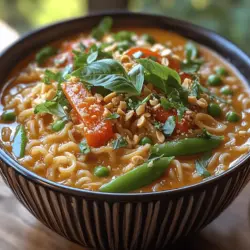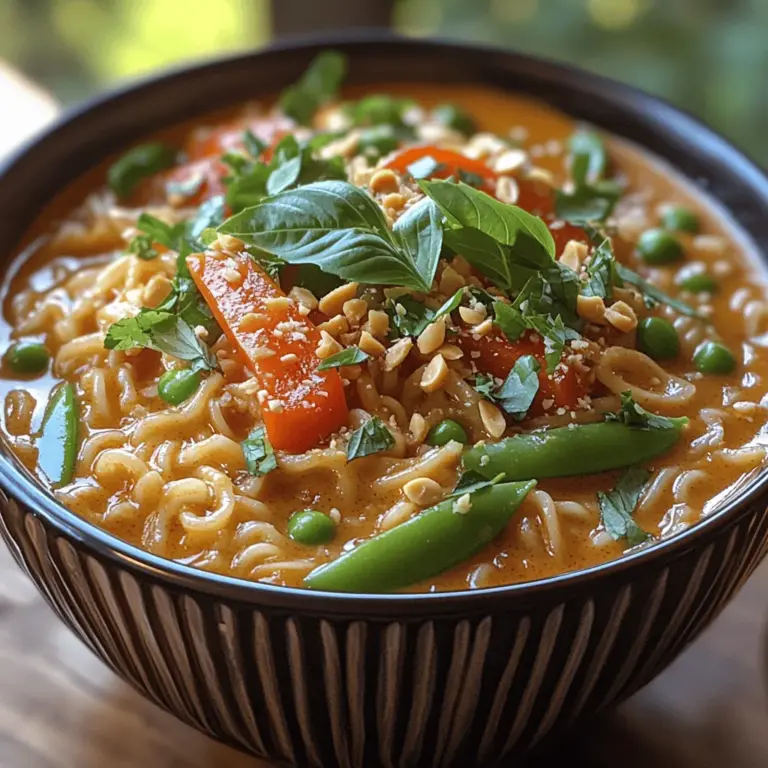Introduction
Thai cuisine is renowned for its vibrant flavors, aromatic herbs, and a balance of sweet, sour, salty, and spicy elements. It has gained immense popularity worldwide, captivating food lovers with its unique combinations and fresh ingredients. Among the many delectable dishes that Thai cuisine offers, Spicy Thai Coconut Curry Noodles stand out as a true crowd-pleaser. This dish not only showcases the rich culinary heritage of Thailand but also embodies the essence of comfort food, making it a favorite in homes and restaurants alike.
Spicy Thai Coconut Curry Noodles are a delightful fusion of flavors and textures that tantalize the taste buds. The creamy richness of coconut milk melds seamlessly with the aromatic spices of red curry, creating a luscious sauce that envelops tender rice noodles. This dish is not just about heat; it’s a harmonious blend of textures from fresh vegetables and the satisfying chew of the noodles, making it both filling and refreshing. Whether you are a fan of spicy foods or prefer milder flavors, this versatile recipe can be tailored to suit various palates.
One of the standout aspects of Spicy Thai Coconut Curry Noodles is its adaptability to different dietary preferences. It can easily be modified to cater to vegan, gluten-free, or vegetarian diets, making it a wonderful choice for gatherings where guests may have diverse dietary needs. The use of fresh, wholesome ingredients ensures that this dish is not only delicious but also nourishing, allowing everyone to enjoy a taste of Thailand in their own kitchen.
Understanding the Ingredients
To create a truly authentic and flavorful bowl of Spicy Thai Coconut Curry Noodles, it’s essential to understand the key ingredients that contribute to its distinctive taste. Each component plays a vital role in building layers of flavor, texture, and nutrition.
Rice Noodles
At the heart of this dish are rice noodles, which serve as the perfect vehicle for the rich coconut curry sauce. These noodles are gluten-free, making them a suitable option for those with gluten sensitivities. Available in various widths, from thin vermicelli to wider flat noodles, rice noodles can be chosen based on personal preference or dish presentation. For a delightful twist, you could also experiment with other varieties such as soba noodles or even zucchini noodles for a low-carb alternative.
Coconut Oil
Coconut oil is a staple in Thai cooking, known for its health benefits and unique flavor. It adds a subtle coconut aroma that enhances the overall dish. Additionally, coconut oil is rich in medium-chain triglycerides (MCTs), which may support metabolic health. If coconut oil is not available, alternatives such as vegetable oil or olive oil can be used, though they may alter the flavor slightly.
Aromatics
The foundation of any great Thai dish lies in its aromatics. In this recipe, onion, garlic, and ginger are crucial for building depth and complexity. The onion provides sweetness, while garlic adds a sharp, pungent flavor, and ginger introduces a warming, spicy note. Together, these ingredients create a fragrant base that enhances the overall dish.
Fresh Vegetables
A variety of fresh vegetables is essential for adding color, crunch, and nutritional value. In this recipe, bell peppers and snow peas or green beans are commonly used. The vibrant colors of the bell peppers not only make the dish visually appealing but also contribute essential vitamins and minerals. Snow peas and green beans provide a satisfying snap and freshness, balancing the creaminess of the coconut sauce.
Coconut Milk
The star of the show is coconut milk, which brings a velvety creaminess to the dish. Made from the flesh of coconuts, it adds richness and a hint of sweetness, perfectly complementing the spiciness of the red curry paste. Coconut milk is also packed with nutrients, including vitamins C and E, iron, and magnesium. If you’re looking for a lighter option, you can use light coconut milk or dilute full-fat coconut milk with water.
Red Curry Paste
Red curry paste is where the magic happens in terms of flavor. This blend of red chilies, garlic, lemongrass, and spices delivers a robust heat that can be adjusted to suit your spice tolerance. The paste is versatile; you can add more or less depending on your preference or even substitute it with green curry paste for a different flavor profile. For those who prefer a milder dish, consider starting with a small amount and gradually increasing it.
Soy Sauce and Brown Sugar
To achieve the perfect balance of flavors, soy sauce and brown sugar are added. Soy sauce contributes depth and umami, enhancing the overall taste of the dish, while brown sugar adds a touch of sweetness to counteract the heat from the curry paste. This combination is crucial for creating a well-rounded flavor profile that is characteristic of Thai cuisine.
Fresh Garnishes
Finally, no bowl of Spicy Thai Coconut Curry Noodles is complete without fresh garnishes. Chopped cilantro, lime wedges, and sliced red chilies not only enhance the presentation but also add fresh flavors that brighten the dish. A squeeze of lime juice just before serving can elevate the taste, bringing all the elements together.
Nutritional Benefits of Spicy Thai Coconut Curry Noodles
In addition to being mouthwateringly delicious, Spicy Thai Coconut Curry Noodles offer several nutritional benefits. The ingredients used in this recipe provide a variety of vitamins, minerals, and healthy fats, making it a wholesome meal choice.
The inclusion of coconut milk is beneficial due to its rich content of healthy fats, particularly medium-chain triglycerides (MCTs), which are known to provide quick energy and may support weight management. Moreover, coconut milk is a source of antioxidants, promoting overall health.
The fresh vegetables contribute essential nutrients, including dietary fiber, vitamins A and C, and antioxidants. Bell peppers are particularly high in vitamin C, which is vital for a healthy immune system, while snow peas are an excellent source of vitamins K and C, as well as folate.
For those with dietary restrictions, this recipe is easily customizable. Gluten-free alternatives can be achieved by using rice noodles, and the dish can be made vegan by ensuring that the curry paste and soy sauce used are free from animal products. By making these adjustments, everyone can enjoy a warm bowl of Spicy Thai Coconut Curry Noodles without compromising their dietary preferences.
Step-by-Step Guide to Making Spicy Thai Coconut Curry Noodles
Now that we’ve explored the delicious ingredients and their benefits, it’s time to dive into the preparation of Spicy Thai Coconut Curry Noodles. This step-by-step guide will take you through the process of creating this flavorful dish, ensuring that you achieve the perfect balance of spices and textures in every bite.
Step 1: Gather Your Ingredients
Begin by assembling all the necessary ingredients. This will make the cooking process smoother and more efficient. Here’s what you’ll need:
– Rice noodles
– Coconut oil
– Onion
– Garlic
– Fresh ginger
– Bell peppers (red and yellow for color)
– Snow peas or green beans
– Coconut milk
– Red curry paste
– Soy sauce
– Brown sugar
– Fresh cilantro and lime for garnishing
Step 2: Prepare the Rice Noodles
Start by cooking the rice noodles according to the package instructions. Usually, this involves soaking them in hot water until they are tender yet firm. Once cooked, drain the noodles and set them aside. Make sure to toss them with a little oil to prevent sticking.
Step 3: Sauté the Aromatics
In a large skillet or wok, heat a tablespoon of coconut oil over medium heat. Add the chopped onion and sauté until it becomes translucent, about 3-4 minutes. Next, stir in the minced garlic and grated ginger, cooking for an additional minute until fragrant. Be careful not to burn the garlic, as it can turn bitter.
Step 4: Add the Vegetables
Once the aromatics are ready, add the sliced bell peppers and snow peas or green beans to the skillet. Stir-fry for about 5 minutes until the vegetables are tender-crisp, maintaining their vibrant colors. The goal is to keep them crunchy and fresh, adding texture to the dish.
Step 5: Incorporate the Coconut Milk and Red Curry Paste
Pour in the coconut milk and add the red curry paste to the skillet. Stir well to combine, allowing the curry paste to dissolve into the coconut milk, creating a creamy sauce. Bring the mixture to a gentle simmer, and let it cook for about 5 minutes to allow the flavors to meld together.
Step 6: Flavor Balancing
Next, add the soy sauce and brown sugar, stirring to incorporate. Taste the sauce and adjust the flavors as necessary. If you prefer it spicier, feel free to add more red curry paste at this point. Allow the sauce to simmer for an additional 2-3 minutes, thickening slightly.
Step 7: Combine with Noodles
Finally, add the cooked rice noodles to the skillet, tossing them gently to coat in the rich coconut curry sauce. Ensure that the noodles are well-mixed and heated through, absorbing the flavors of the sauce.
Step 8: Serve and Garnish
Once the noodles are thoroughly combined with the sauce, remove the skillet from heat. Serve the Spicy Thai Coconut Curry Noodles in bowls, garnishing with chopped cilantro and lime wedges for an extra burst of flavor.
With these steps, you are well on your way to creating a delicious and satisfying dish that highlights the essence of Thai cuisine. Enjoy the rich flavors and aromatic spices that make Spicy Thai Coconut Curry Noodles a standout meal for any occasion.
Stay tuned for the next part of this article where we will explore tips for achieving the perfect dish and answer some common questions about this delightful recipe.
{{image_2}}
Cooking the Noodles: Tips for Perfect Texture
The foundation of any great noodle dish is perfectly cooked noodles. For Spicy Thai Coconut Curry Noodles, the type of noodle you choose greatly influences the overall experience. Rice noodles are traditional in Thai cuisine, offering a light and chewy texture that absorbs the rich flavors of the curry sauce.
1. Choosing the Right Noodles: Look for flat rice noodles, commonly labeled as “pad Thai” noodles or “rice vermicelli.” These options will give you the best texture when paired with the sauce.
2. Soaking Method: If you’re using dried rice noodles, soak them in hot water instead of boiling. This method allows the noodles to soften without becoming mushy. Aim for about 20-30 minutes, checking for the desired tenderness.
3. Timing is Key: Drain the noodles just before adding them to the pan. They should be slightly undercooked since they will continue to cook when mixed with the hot sauce and vegetables.
4. Avoiding Stickiness: To prevent the noodles from sticking together, toss them with a small amount of oil after draining. This keeps them separate and allows for better coating with the sauce later.
Sautéing Aromatics: Achieving the Right Flavor Base
The flavor base is crucial for creating depth in your Spicy Thai Coconut Curry Noodles. Sautéing aromatics brings out their natural oils and enhances the dish’s overall taste.
1. Choosing Aromatics: Start with fragrant ingredients like minced garlic, ginger, and finely chopped shallots. These add layers of flavor and are essential in Thai cuisine.
2. Heat Control: Use medium heat to sauté the aromatics gently. This ensures they become aromatic without burning, which can lead to bitterness. Stir frequently, allowing them to soften and release their natural oils.
3. Adding Spice: For a spicy kick, incorporate red curry paste or a combination of chili flakes and fresh chili peppers during this step. This allows the flavors to meld beautifully with the aromatics, creating a well-rounded base.
Adding Vegetables: Timing for Optimal Crunch
Vegetables add not only flavor but also texture and color to your dish. The timing of when you add them is essential to maintain a satisfying crunch.
1. Choosing Your Vegetables: Bell peppers, carrots, snap peas, and baby corn are excellent choices. They provide a variety of textures and flavors that complement the curry.
2. Cooking Order: Start by adding the vegetables that take the longest to cook, like carrots, and then progressively add quicker-cooking options like bell peppers and snap peas. This method ensures everything is cooked perfectly and retains some crunch.
3. Stir-Frying Technique: Stir-fry the vegetables for just a few minutes until they are vibrant and tender-crisp. This technique enhances their natural sweetness and keeps the dish colorful.
Creating the Sauce: Importance of Simmering for Flavor Development
The sauce is where all the magic happens. It ties together the noodles, vegetables, and aromatics, creating a harmonious blend of flavors.
1. Coconut Milk Base: Start with a can of full-fat coconut milk for a creamy texture that balances the heat from the spices.
2. Simmering: After adding the coconut milk, bring the sauce to a gentle simmer. This step is crucial as it allows the flavors to meld together. Let it simmer for about 5-10 minutes, stirring occasionally, until it thickens slightly.
3. Adjusting Consistency: If the sauce becomes too thick, add a splash of vegetable broth or water to reach your desired consistency. Be cautious not to dilute the flavor.
Combining Noodles and Sauce: Techniques for Even Coating
Achieving the perfect combination of noodles and sauce is key to a well-balanced dish.
1. Mixing Method: Once the sauce is ready, add the drained noodles directly into the pan with the sauce. Use tongs or two forks to gently toss the noodles, ensuring every strand is coated evenly.
2. Heat Integration: Allow the noodles to simmer in the sauce for a couple of minutes. This helps the noodles absorb the flavors while ensuring they are heated through.
3. Garnishing: Finally, consider garnishing with fresh herbs such as cilantro or basil, adding a fresh element that balances the richness of the coconut milk.
Finishing Touches: The Role of Lime Juice in Flavor Enhancement
A splash of lime juice can elevate your dish from delicious to exceptional. The acidity cuts through the richness of the coconut, enhancing the overall flavor profile.
1. Freshness Factor: Squeeze fresh lime juice just before serving. This brightens the dish and adds a refreshing zing that complements the spices.
2. Zest for Depth: Grate some lime zest over the top for an extra layer of citrus flavor. This simple addition enhances the aroma and adds visual appeal.
Flavor Balancing Techniques
Thai cuisine is renowned for its ability to balance heat, sweetness, and acidity. Here are some techniques to help you perfect this balance in your Spicy Thai Coconut Curry Noodles.
1. Balancing Heat: If you find the dish too spicy, add a touch of sweetness with sugar or honey. Conversely, if it’s not spicy enough, feel free to add more curry paste or fresh chilies.
2. Sweetness Adjustments: Coconut milk provides a natural sweetness, but you can enhance this with a pinch of sugar or palm sugar for a more authentic Thai flavor.
3. Acidity Tuning: Lime juice is essential for cutting through the richness. If you feel the dish lacks brightness, add another squeeze of lime or a dash of rice vinegar for additional acidity.
4. Personalizing Flavor Profiles: Don’t hesitate to experiment with other ingredients such as tofu, shrimp, or chicken for added protein. You can also switch up the vegetables based on seasonal availability or personal preference.
Serving Suggestions
When it comes to serving Spicy Thai Coconut Curry Noodles, presentation and pairing can enhance the dining experience.
1. Ideal Serving Sizes: Aim for generous servings, as the dish is both filling and satisfying. A standard serving is about one and a half cups of noodles per person.
2. Presentation Techniques: Use shallow bowls to showcase the vibrant colors of the dish. Top with fresh herbs, lime wedges, and a sprinkle of sesame seeds or crushed peanuts for added texture.
3. Pairing Ideas: Serve with a side of Thai spring rolls or a light cucumber salad to balance the richness of the noodles. For beverages, consider pairing with a light lager or a refreshing iced tea.
4. Meal Prep and Storage: Leftovers can be stored in an airtight container in the refrigerator for up to three days. To reheat, add a splash of coconut milk or broth to loosen the sauce and prevent the noodles from drying out.
Cultural Significance of Thai Cuisine
Thai cuisine is rich in history and culture, reflecting the country’s diverse influences and culinary traditions.
1. Brief History: Originating from various regions, Thai cooking has evolved over centuries, influenced by neighboring countries such as China, India, and Malaysia. The balance of flavors is a hallmark of Thai cooking, making it unique.
2. The Role of Curry: Curry is central to Thai dining, embodying the harmony of flavors that Thai chefs strive for. Each region has its distinct curry styles, showcasing local ingredients and cooking techniques.
3. Culinary Philosophy: This dish exemplifies the essence of Thai cooking, focusing on fresh ingredients, balanced flavors, and the art of presentation. It invites diners to experience a symphony of tastes in every bite.
Conclusion
Spicy Thai Coconut Curry Noodles is a dish that showcases the beauty of Thai cuisine through its vibrant flavors and comforting texture. The combination of creamy coconut, aromatic spices, and fresh vegetables creates a delightful culinary experience that is both satisfying and invigorating.
As you embark on your journey with this recipe, don’t hesitate to experiment and make it your own. Thai cooking is about creativity and balance, encouraging you to explore different ingredients and flavor profiles. Sharing this dish with family and friends will not only introduce them to the wonders of Thai cooking but also create a memorable dining experience filled with joy and flavor.
So, gather your ingredients, unleash your inner chef, and enjoy the process of creating this beautiful dish. The world of Thai cuisine awaits your exploration!


